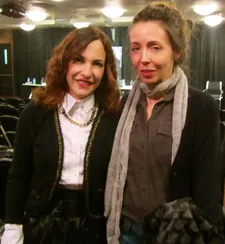Instituto Cervantes New York hosted a press conference with Pablo Berger, director/screenwriter of Blancanieves, and director/screenwriter Paula Ortiz of Chrysalis aka De tu ventana a la mía, moderated by Richard Peña for the Film Society of Lincoln Center's Spanish Cinema Now. Maribel Verdú, Leticia Dolera and Luisa Gavasa give masterful performances in Ortiz's feature debut as they weave in and out of narratives that could be reflections of Lillian Gish from Victor Sjöström's The Wind or Emmanuelle Riva from Alain Resnais' Hiroshima, Mon Amour.
 |
| Paula Ortiz, Richard Peña, Pablo Berger at the Spanish Cinema Now press conference. Photo: Anne-Katrin Titze |
In my conversation with Paula Ortiz we spoke about the telling of three women, three destinies and the history of Spain in the 20th century.
Fairy tales are present in her movie, as they are in Blancanieves by Berger, with whom I had a snow white conversation earlier and whose cast also features the irresistible Maribel Verdú.
Anne-Katrin Titze: You are telling three stories of three women. Was it clear for you from the start that you would set their stories in the 1920s, the 1940s and the 1970s?
Paula Ortiz: Yes, the idea of the movie was trying to tell the story of the women in Spain through the 20th century. I tried for it to be like a kaleidoscope of many, many, many women. Many lives. But we needed to crystalise them. Three stories, three ages of life, three landscapes and three moments of the history of Spain. The first character, Violeta (Leticia Dolera) lives in the Twenties, between the two republics in Spain. It was a very interesting moment, especially for education, intellectuals, and for the possibilities for women.
AKT: You show her character wanting to go to Paris, to the Sorbonne, to study.
PO: Right. Then the second one, in 1941 is just after the Civil War, the beginning of the dictatorship. A really, really hard moment, very difficult for anyone. This is another kind of story, of women in lands with nothing.
AKT: Your choice for the landscape was brilliant. That wind and the desert and the strength of Maribel Verdú's character Inés reminded me of Victor Sjöström's The Wind (1928) with Lillian Gish.
PO: That was real. And that wind was very important for the character. My grandmother lived in that landscape. They were really strong women.
AKT: The woman of the wind and the man who is in the cave in the mountains. That is a good juxtaposition visually.
PO: Open in the landscape, so, so open, and so dry and so hot at the same time. And the third one in '75/'76, it was the moment when Franco died and it was a really interesting moment when Spain came into democracy. So it was a transition as well. A character in transition like the country, reconstructing herself.
AKT: The structuring in threes is also a common fairy tale device and matches some of your other themes. The cutting of fingers that turn the wool red. And you have to think Rapunzel when three women have their hair cut for various traumatic reasons. Can you talk about the cutting of the hair?
PO: Yes, the cutting of the hair for me was a symbol of the weakness in the three of them. For the women individually, but as well socially and culturally the hair is the symbol of femininity, of beauty. If you think about the religions, all the religions try to cut the hair or cover the hair. Muslim, Jewish, Catholic all of them.
AKT: Fear of the hair.
 |
| Paula Ortiz with Anne-Katrin Titze at Instituto Cervantes New York. Photo: Lola Suárez |
PO: Yeah, it's fear. It is fear of the hair. The wild women used to be an image like that. I wanted to join the three of them, three lives in different moments, different conflict, different pain. At one moment the one thing that was the symbol for the three of them was the hair. One of them because of illness, one because of the rape and one because of the social and political situation. The military used to do that to the wives or daughters of republicans to show to the other people in the village.
AKT: It also connects them to other women, outside of Spain. I am thinking of Alain Resnais' 1959 Hiroshima, Mon Amour, for example, and the punishment for the Nazi collaborators.
PO: There is another Indian movie, very beautiful, that tells the same story. When Indian women become widows, then they cut their hair and they retire.
AKT: Better than the custom of burning the widows themselves… Tell me about the title change from the Spanish title which translates as From Your Window To Mine to the English one Chrysalis. Was this your choice? Was it suggested to change it?
PO: I like the title From Your Window To Mine, but in Spanish, it's the beginning of a song. A popular, very ancient song. I liked very much the title because it was talking between two people. From my window to yours, from your window to mine.
AKT: The two people are both female in the song, or you don't know?
PO: You don't know. It's very symbolic and a very popular song in the lands inside of Spain. When we tried to translate it into English, they said it doesn't mean the same. "We don't have the song. Maybe it's too long." So there was another title that I liked as well which is Chrysalis because of the butterfly symbol.
AKT: I didn't know about the song and the title made me think of the beginning of Snow White, with the mother sitting in the window frame, pricking her finger, which is a motif in your film.
PO: I think there's a strong image with all the women knitting in the window or preparing something of the food in the window. Doing small things, not as important things as men. But they were doing very, very important things, and very important conversations did take place in the windows.
AKT: Being in between the house and the outside world is a crucial location. The refusal to die before living a great love and cutting out the photos of Vivien Leigh define your third character. What is her story?
PO: This story of Luisa (Luisa Gavasa) is inspired by my great aunt. She lives alone, she didn't get married but she constructed by herself to herself little symbols that she was happy with that world. With, you know, Vivien Leigh pictures, the movies, the opera, Zarzuela, which is a kind of opera in Spain, and all of these ideas of platonic loves. My idea with this story was to try and tell how a woman like this, alone her whole life, suddenly, because of a really strong shock in her life, like the cancer, she starts to live reality. She keeps her own world, the Vivien Leigh, Alfredo Kraus, and all of that stuff that makes her happy but at the same time starts to live her own life. At the end she goes out and says, "yes, I am sick but I am alive and well, and I love my cousin."
AKT: She is in the "real world," whatever that means. How close were you to your aunt?
PO: Very, very close, because she used to take care of me and my brother when my mother and my father were working.
AKT: Some of her ideas might have inspired you to become a filmmaker?
PO: Yes, oh yes. Maybe not a filmmaker but when I was a child she used to comment on me and my tales. And she really supported that. Not everybody supports that creativity.
AKT: She saw your film?
PO: No, no she died, ten years ago.
AKT: I love the scenes in the old shop, with all the drawers and ribbons. Did you remember these kinds of shops from your childhood?
PO: Yes, I remember, because all the women in my family - and there were a lot of women, because my mother had four sisters and my grandmother had four sisters as well - I remember all of them buying in this kind of store all the stuff to make dresses.
AKT: I remember them as well, going with my grandmother in a small town to these dark, dusty, smelly places that had miraculous objects in many drawers. They seem to be international and you captured the feel.
PO: And I liked the idea of a man working there in that female universe. I liked how the character of Valentin (Luis Bermejo) works with women every day and he likes Luisa. Just Luisa.
AKT: Is there a theme, as a filmmaker, that is closest to your heart, that you want to explore?
PO: In all my stories loneliness is a theme. Especially for me, it's trying to tell the story, the small line between reality and non-reality. Not in fantastic stories, no. Just like in the tales, the fairy tales. Like in the symbolic tales in that small territory between real and non-real. I like storytelling because of the rhythm and sense of the symbol.
AKT: Let's end with some favorite filmmakers.
PO: I like very much Sam Mendes, Patrice Leconte, Zhang Yimou, Wong Kar-Wai, the Coen brothers. And Terrence Malick, I love his aesthetics and ethics.
Chrysalis (De Tu Ventana A La Mía) is a remarkable film about perseverance of spirit with images that stay with you.





















